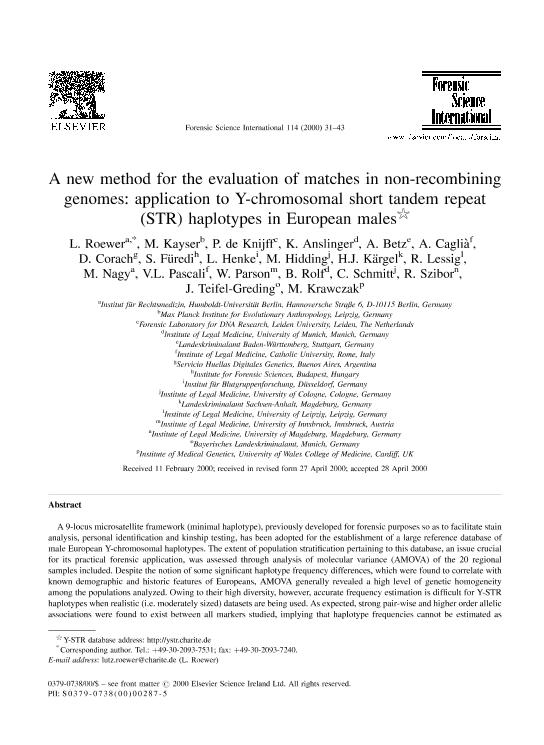Mostrar el registro sencillo del ítem
dc.contributor.author
Roewer, L.
dc.contributor.author
Kayser, M.
dc.contributor.author
De Knijff, P.
dc.contributor.author
Anslinger, Katja

dc.contributor.author
Betz, A.
dc.contributor.author
Caglià, A.
dc.contributor.author
Corach, Daniel

dc.contributor.author
Füredi, S.
dc.contributor.author
Henke, L.
dc.contributor.author
Hidding, M.
dc.contributor.author
Kärgel, H.J.
dc.contributor.author
Lessig, R.
dc.contributor.author
Nagy, M.
dc.contributor.author
Pascali, V. L.
dc.contributor.author
Parson, Walther

dc.contributor.author
Rolf, B.
dc.contributor.author
Schmitt, C.
dc.contributor.author
Szibor, R.
dc.contributor.author
Teifel-Greding, J.
dc.contributor.author
Krawczak, M.
dc.date.available
2018-03-19T19:51:01Z
dc.date.issued
2000-10
dc.identifier.citation
Roewer, L.; Kayser, M.; De Knijff, P.; Anslinger, Katja; Betz, A.; et al.; A new method for the evaluation of matches in non-recombining genomes: Application to Y-chromosomal short tandem repeat (STR) haplotypes in European males; Elsevier Ireland; Forensic Science International; 114; 1; 10-2000; 31-43
dc.identifier.issn
0379-0738
dc.identifier.uri
http://hdl.handle.net/11336/39260
dc.description.abstract
A 9-locus microsatellite framework (minimal haplotype), previously developed for forensic purposes so as to facilitate stain analysis, personal identification and kinship testing, has been adopted for the establishment of a large reference database of male European Y-chromosomal haplotypes. The extent of population stratification pertaining to this database, an issue crucial for its practical forensic application, was assessed through analysis of molecular variance (AMOVA) of the 20 regional samples included. Despite the notion of some significant haplotype frequency differences, which were found to correlate with known demographic and historic features of Europeans, AMOVA generally revealed a high level of genetic homogeneity among the populations analyzed. Owing to their high diversity, however, accurate frequency estimation is difficult for Y-STR haplotypes when realistic (i.e. moderately sized) datasets are being used. As expected, strong pair-wise and higher order allelic associations were found to exist between all markers studied, implying that haplotype frequencies cannot be estimated as products of allele frequencies. A new extrapolation method was therefore developed which treats haplotype frequencies as random variables and generates estimates of the underlying distribution functions on the basis of closely related haplotypes. This approach, termed frequency 'surveying', is based upon standard population genetics theory and can in principle be applied to any combination of markers located on the Y-chromosome or in the mitochondrial genome. Application of the method to the quality assured reference Y-STR haplotype database described herein will prove very useful for the evaluation of positive trace-donor matches in forensic casework. (C) 2000 Elsevier Science Ireland Ltd.
dc.format
application/pdf
dc.language.iso
eng
dc.publisher
Elsevier Ireland

dc.rights
info:eu-repo/semantics/openAccess
dc.rights.uri
https://creativecommons.org/licenses/by-nc-sa/2.5/ar/
dc.subject
Analysis of Molecular Variance
dc.subject
Haplotype Diversity
dc.subject
Haplotype Frequency Estimation
dc.subject
Reference Database
dc.subject
Y-Str Haplotype
dc.subject.classification
Otras Ciencias Biológicas

dc.subject.classification
Ciencias Biológicas

dc.subject.classification
CIENCIAS NATURALES Y EXACTAS

dc.title
A new method for the evaluation of matches in non-recombining genomes: Application to Y-chromosomal short tandem repeat (STR) haplotypes in European males
dc.type
info:eu-repo/semantics/article
dc.type
info:ar-repo/semantics/artículo
dc.type
info:eu-repo/semantics/publishedVersion
dc.date.updated
2018-03-16T15:13:10Z
dc.journal.volume
114
dc.journal.number
1
dc.journal.pagination
31-43
dc.journal.pais
Irlanda

dc.journal.ciudad
Shannon
dc.description.fil
Fil: Roewer, L.. Universität zu Berlin; Alemania
dc.description.fil
Fil: Kayser, M.. Institut Max Planck for Evolutionary Anthropology; Alemania
dc.description.fil
Fil: De Knijff, P.. Leiden University; Países Bajos
dc.description.fil
Fil: Anslinger, Katja. Universitat Technical Zu Munich; Alemania
dc.description.fil
Fil: Betz, A.. Landeskriminalamt Baden-Württemberg; Alemania
dc.description.fil
Fil: Caglià, A.. Catholic University. Institute of Legal Medicine; Italia
dc.description.fil
Fil: Corach, Daniel. Universidad de Buenos Aires. Facultad de Farmacia y Bioquímica. Servicio de Huellas Digitales Genéticas; Argentina. Consejo Nacional de Investigaciones Científicas y Técnicas. Oficina de Coordinación Administrativa Houssay; Argentina
dc.description.fil
Fil: Füredi, S.. Institute for Forensic Sciences; Hungría
dc.description.fil
Fil: Henke, L.. Institut für Blutgruppenforschung; Alemania
dc.description.fil
Fil: Hidding, M.. Universitat Zu Köln; Alemania
dc.description.fil
Fil: Kärgel, H.J.. Landeskriminalamt Sachsen-Anhalt; Alemania
dc.description.fil
Fil: Lessig, R.. University of Leipzig; Alemania
dc.description.fil
Fil: Nagy, M.. Universität zu Berlin; Alemania
dc.description.fil
Fil: Pascali, V. L.. Catholic University. Institute of Legal Medicine; Italia
dc.description.fil
Fil: Parson, Walther. Universidad de Innsbruck; Austria
dc.description.fil
Fil: Rolf, B.. Universitat Technical Zu Munich; Alemania
dc.description.fil
Fil: Schmitt, C.. Universitat Zu Köln; Alemania
dc.description.fil
Fil: Szibor, R.. Otto-von-Guericke-Universität Magdeburg; Alemania
dc.description.fil
Fil: Teifel-Greding, J.. Bayerisches Landeskriminalamt; Alemania
dc.description.fil
Fil: Krawczak, M.. University of Wales College of Medicine; Reino Unido
dc.journal.title
Forensic Science International

dc.relation.alternativeid
info:eu-repo/semantics/altIdentifier/url/https://www.sciencedirect.com/science/article/pii/S0379073800002875
dc.relation.alternativeid
info:eu-repo/semantics/altIdentifier/doi/http://dx.doi.org/10.1016/S0379-0738(00)00287-5
Archivos asociados
